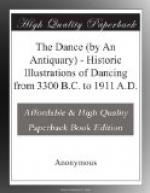[Illustration: Fig. 62.—Pauline Duvernay at Covent Garden, 1833-1838.]
The foundation of the theatrical ballet was, however, at the instigation of Mazarin, to prevent a lowering of tone in the establishment of the Academie de Danse under thirteen Academicians in 1661. This appears to have been merged into the Academie Royale de Musique et de Danse in 1669, which provided a proper training for debutants, under MM. Perrin and Cambert, whilst Beauchamp, the master of the Court ballets, had charge of the dancing. The first opera-ballet, the “Pomona” of Perrin and Cambert, was produced in 1671. To this succeeded many works of Lulli, to whom is attributed the increased speed in dance music and dancing, that of the Court ballets having been slow and stately.
[Illustration: Fig. 63.—Mlle. Fanny Ellsler. From a lithograph by A. Lacaucbie.]
The great production of the period appears to have been the “Triumph of Love” in 1681, with twenty scenes and seven hundred performers; amongst these were many of the nobility, and some excellent ballerine, such as Pesaut, Carre, Leclerc, and Lafontaine.
A detailed history of the ballet is, however, impossible here, and we must proceed to touch only on salient points. It passed from the Court to the theatre about 1680 and had two characteristics, one with feminine dancers, the other without.
[Illustration: Fig. 63a.—Dancing satyr playing castanets, by Myron, in the Vatican Museum. The action is entirely suggestive of that of Fanny Ellsler, and might be evidence of the antiquity of the Spanish tradition.]
It is not a little curious that wearing the mask, a revival of the antique, was practised in some of these ballets. The history of the opera-ballet of those days gives to us many celebrated names of musicians, such as Destouches, who gave new “verve” to ballet music, and Rameau. Jean Georges Noverre abolished the singing and established the five-act ballet on its own footing in 1776. In this it appears he had partly the advice of Garrick, whom he met in London. The names of the celebrated dancers are numerous, such as Pecourt, Blaudy (who taught Mlle. Camargo), Laval, Vestris, Germain, Prevost, Lafontaine, and Camargo (fig. 61), of the 18th century; Taglioni, Grisi, Duvernay, Cerito, Ellsler, etc., of the 19th century, to those of our own day. A fair notice of all of these would be a work in itself.
[Illustration: Fig. 64.—Mlle. Taglioni. From a lithograph of the period.]
The introduction of the ballet into England was as late as 1734, when the French dancers, Mlle. Salle, the rival of Mlle. Camargo, and Mlle. de Subligny made a great success at Covent Garden in “Ariadne and Galatea,” and Mlle. Salle danced in her own choregraphic invention of “Pygmalion,” since which time it has been popular in England, when those of the first class can be obtained. There are, however, some interesting and romantic circumstances connected with the ballet in London in the last century, which it will not be out of place to record here. Amongst the dancers of the last century of considerable celebrity were two already mentioned, Mlles. Duvernay (fig. 62) and Taglioni (fig. 64), whose names are recorded in the classic verse of “Ingoldsby.”




